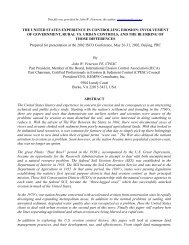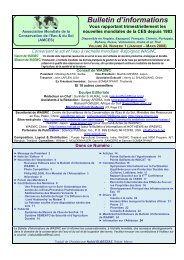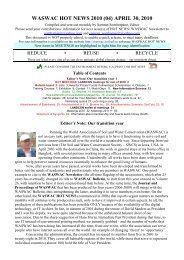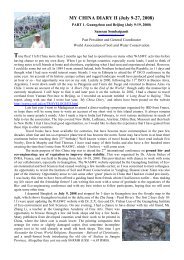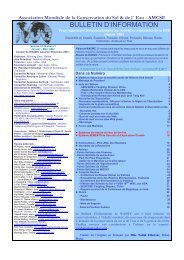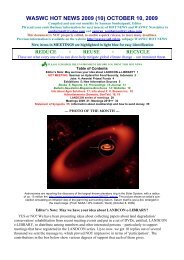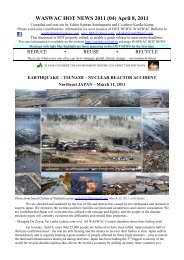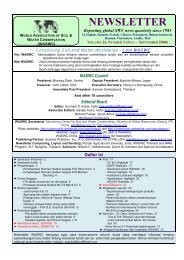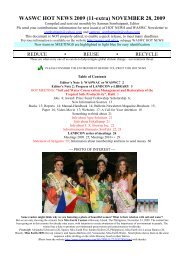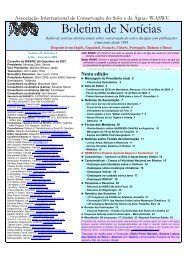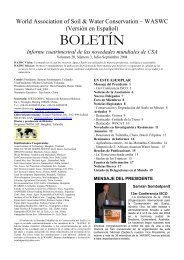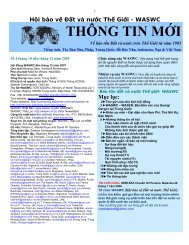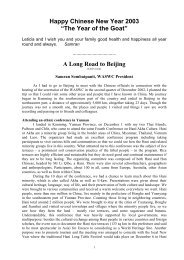Soils of the European Union - European Soil Portal - Europa
Soils of the European Union - European Soil Portal - Europa
Soils of the European Union - European Soil Portal - Europa
Create successful ePaper yourself
Turn your PDF publications into a flip-book with our unique Google optimized e-Paper software.
4.7 CambisolsGeographical distribution<strong>Soil</strong> types in <strong>the</strong> Calcisol Reference <strong>Soil</strong> Group with over 1.1 million km 2 areal coverage account for <strong>the</strong> most widespreadsoils in <strong>the</strong> <strong>European</strong> <strong>Union</strong>, covering more <strong>the</strong>n a quarter <strong>of</strong> its territory. Cambisols can be found nearly all regions <strong>of</strong> <strong>the</strong>EU; as dominant soil in 5,236, as associated soil in 4,098 and as inclusions in 3,231 polygons.Eight different subgroups contribute to <strong>the</strong> Cambisol coverage <strong>of</strong> <strong>the</strong> <strong>European</strong> <strong>Union</strong>, with Dystric Cambisols having <strong>the</strong>largest and Haplic Cambisol <strong>the</strong> lowest share (Table 4.7., Figure 4.7).Table 4.7 Area <strong>of</strong> <strong>the</strong> second level units <strong>of</strong> CambisolsUnits in <strong>the</strong> Reference <strong>Soil</strong> Groupin <strong>the</strong> EUCodes <strong>of</strong>soil unitsArea in <strong>the</strong> EUkm 2Calcaric Cambisol CMca 201257Chromic Cambisol CMcr 47566Dystric Cambisol CMdy 386271Eutric Cambisol CMeu 339972Gleyic Cambisol CMgl 45198Haplic Cambisol CMha 476Mollic Cambisol CMmo 53832Vertic Cambisol CMvr 33025Calcaric Cambisols are most common in Spain. In most regions <strong>of</strong> France, Calcaric Cambisols are quite common too.O<strong>the</strong>r countries with considerable Calcaric Cambisol areas include Italy, Germany, Greece, Poland, Estonia, Portugal and<strong>the</strong> Ne<strong>the</strong>rlands. Cromic Cambisols have <strong>the</strong> highest relative share in Hungary, but Italy, France and Portugal have alsoregions with dominantly Cromic Cambisol and this soil unit is present in <strong>the</strong> UK, Greece and Portugal as well. In <strong>the</strong> CzechRepublic Dystric Cambisols are <strong>the</strong> most common soils and <strong>the</strong>y also have a considerable share in <strong>the</strong> soil cover <strong>of</strong> almostall EU Member States (exceptions are <strong>the</strong> Baltic States, Poland, Hungary, Malta and <strong>the</strong> Ne<strong>the</strong>rlands). Eutric Cambisolscan be found as associated soils all over <strong>the</strong> EU (Except Finland, Latvia, Estonia, Cyprus and Malta) and are also dominantin <strong>the</strong> Po plain, <strong>the</strong> Alsace-Loire region, Bretagne, Bavaria, <strong>the</strong> High Tatras, in <strong>the</strong> western Pyrenees and <strong>the</strong> ScottishCentral Lowlands. Gleyic Cambisols are dominant in parts <strong>of</strong> central Lithuania, south-eastern England and are alsoabundant in <strong>the</strong> French Massif Central, in Central Europe, and as inclusion in <strong>the</strong> Po plain. Areas <strong>of</strong> Haplic Cambisols arelimited to Cyprus and <strong>the</strong> Ne<strong>the</strong>rlands. Mollic Cambisols are widespread in north-western Iberia, in <strong>the</strong> Massif Central <strong>of</strong>France, <strong>the</strong> Pyrenees, throughout Hungary, and in some parts <strong>of</strong> Romania, Bulgaria and Greece. Vertic Cambisols areabundant in Germany, Finland, Italy and Greece and has inclusions in Austria, Cyprus and Czech Republic.0.04%4.86% 2.98%4.08%30.69%18.17%4.29%34.87%CMcaCMcrCMdyCMeuCMglCMhaCMmoCMvrFigure 4.7 Share <strong>of</strong> <strong>the</strong> second level soil units in <strong>the</strong> area <strong>of</strong> CambisolsGlobal referenceA Cambisol is a young soil. Pedogenic processes are evident from color development and/or structure formation below <strong>the</strong>surface horizon. Cambisols occur in a wide variety <strong>of</strong> environments around <strong>the</strong> world (15M km 2 global coverage) andunder all kinds <strong>of</strong> vegetation. Cambiols in <strong>the</strong> international classifications are referred to as brown soil, Braunerde(Germany), Sols bruns (France) or Brunizems (Russia). The USDA <strong>Soil</strong> Taxonomy classifies Cambisols as Inceptisols.24




